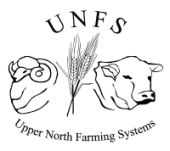Full Name: Building resilience – Break Crop Suitability Across Landscapes
Funding Body: SA Drought Hub
Duration: 2024/25
Project Lead: UNFS
Contact: Rachel Trengove, UNFS
Demonstration Paddock Locations: Murray Plains Farming (MFP) -Punthari
Ag Innovation & Research Eyre Peninsula (AIREP) – Ungarra & Lock
UNFS – Booleroo Centre & Jamestown
Background: Managing break crops across the landscape can be a balancing act. With many break crop options having an attractive $/t end point, the use of break crops in the cropping system has gained momentum in the last few years. Understanding landscape volatility such as soil type, water holding capacity and frost are important variables to consider when making break crop decisions and improving resilience to tough conditions such as drought. While the use of break crops in the rotation offers many benefits such as weed management and N fixation, they also pose several risks including high costs of inputs, establishment issues, sensitivity to drought, prone to frost, limited end use options, and fragile residual stubble/ground cover.
Objective: Several paddock scale demonstration sites are established, tailoring each to the needs of the group region. The activities are designed to share information about break crop options and agronomics looking at crop establishment, soil testing (deep N), in crop monitoring, yield and economic analysis, ground cover/stubble residues and benefits for the following crop.
The SARDI Waite Agronomy team will help conduct a paddock demonstration site of canola and lentils for the Murray Plains Farmers group at Punthari in the Murray Plains. The aim of the demonstration will be to highlight the benefits and risks of having either lentils or canola as a break crop across variable soil types.
The SARDI Clare Agronomy team will help conduct a paddock demonstration site of lentils and intercropping for the Upper North Farming Systems group at Melrose and Jamestown. The aim of the demonstration will be to assess the suitability of lentils in areas that have been typically unsuitable for their growth due to heavier soil types, waterlogging and frost risk.
The SARDI Minnipa Agricultural Centre Agronomy team will help conduct a paddock demonstration site of vetch and lentils at Calca on western Eyre Peninsula and a site of beans and lentils at Ungarra on the lower Eyre Peninsula for AIR EP. The aim of the demonstration will be to highlight the benefits and risks of having break crops across different soil types.
For all demonstrations, measurements are taken on key factors that influence the relative sustainability and profitability of each break crop in their farming system which will include soil nutrition, plant establishment, anthesis biomass, feed quality analysis (for alternate end use in drought), grain yield, grain quality and stubble residual. The demonstrations will aid growers to select a break crop species better suited to a soil type and landscape, that will reduce the downside risk of crop failure and reduced profitability etc.


